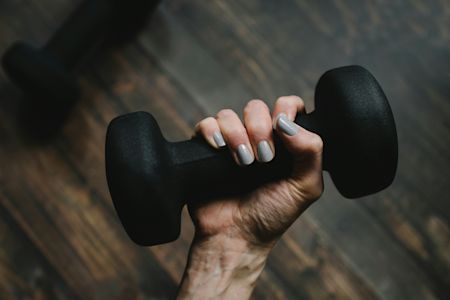“I dropped 2 dress sizes in 5 months – I turned my life around”
“I would tell my January self to stick with it as I was about to fall in love with exercise."
Sign up to The Body Coach newsletter to get inspiration in your inbox every Monday.

In this guest blog post, Dr Louise Newson talks about how women can get the most out of exercise and their workouts while going through perimenopause or menopause.
In my experience as a doctor and menopause specialist, the women who have the best menopause are those who take a holistic approach to their health. And a core component of that is exercise.
I know it can be hard to muster the energy to exercise if you are struggling with symptoms brought on by hormone changes in perimenopause and menopause: your knees might hurt, your muscles might be aching, you may have low stamina and reduced energy levels and perhaps you’ve put on weight or you’re worried about having a hot flush in the middle of a workout.
But the benefits of exercise are so numerous that it’s a crucial part of your menopause management toolkit. Exercise helps keep your bones strong, it’s good for your mental health, reduces risk of cardiovascular disease and when combined with a balanced diet, it can help you maintain a healthy weight.
Common barriers to regular exercise – and how to overcome them
It’s never too late to start exercising or to get back to exercise. If you’re struggling to find the motivation to do so, then you aren’t alone. A poll of nearly 6,000 women to coincide with my book, The Definitive Guide to Perimenopause and Menopause, found that while three quarters (77%) of women recognised the physical and mental health benefits to exercising, nearly a third admit they exercise less than once a week or not at all.
The main barriers to exercise, according to the women in my survey, were a lack of motivation (51%), followed by a lack of time (42%). And nearly a third were unable to exercise more due to their menopausal symptoms.
That last stat is so important: I often speak to women who were avid runners or loved the gym before their perimenopause or menopause started, but symptoms like joint aches and pains, fatigue and vaginal dryness have become barriers to a regular exercise routine.
Don’t try to fight your symptoms – if they are affecting your everyday life, speak to a healthcare professional about treatment. Hormone replacement therapy (HRT) is the first-line treatment to manage menopause symptoms by replacing the hormones your body is lacking. Evidence clearly shows that the earlier a woman starts taking HRT, the better for their future health.
However, it is never too late to start taking HRT – we usually prescribe natural body identical hormones which are very safe and effective. You will likely find that once your symptoms have improved, your motivation to exercise returns too.
How much should I be exercising in menopause?
The best advice I can give is to start small and work your way up to a regular exercise routine.
The UK government guidelines for exercise state that adult women should be exercising for half an hour a day, five times a week, as well as doing strength exercises on two days a week. Strength exercises like yoga or Pilates or using weights or resistance bands – basically any activity where your muscles work harder than usual to improve strength and endurance – is particularly important during menopause, as falling oestrogen levels affect your bone density, and the risk of osteoporosis increases after the menopause.
I know that sounds like a lot written down, but if you stop thinking about ‘exercise’ and start thinking about ‘activity’ instead, it can seem less daunting and a lot more manageable. The goal is to be active throughout your week, not necessarily to become a super athlete!
Be realistic about your goals
Setting realistic, specific goals can give you a sense of purpose and keep you on track. Identify what you want to achieve through physical activity – whether it’s boosting your mood, managing weight, improving sleep, or enhancing wellbeing. Do not compare yourself to others and don’t pick goals based on anyone else. Make them relevant and meaningful to you.
Find an activity you love – and you’ll be more likely to stick to it
When it comes to the type of exercise you do, I’m passionate about personal choice. Take my own exercise preferences, for example. My friends love going to classes, but I prefer exercising on my own, and yoga suits my life because I’m in control of it. My job is incredibly hectic, and not having to head to a gym or a yoga studio to exercise or worry about missing a class if the clinic runs late works for me. I can flick my yoga mat out anytime, anywhere, whether at home early in the morning before work or in a hotel room, if I’m away at a conference.
Make it social
Movement can be more enjoyable when done with others and helps you to stick to it as you’ll not want to let a friend down. Consider joining group classes, clubs, or participating in activities with friends or family. In my survey, walking was by far the most popular form of exercise, with 75% of respondents saying it benefitted their physical and mental health. Yoga, strength training and Pilates were also popular and all of these can be done with a friend or in a group.
And if you’re not enjoying an exercise, there’s no rule to say you have to stick with it week in, week out. Mix it up, try something new but most importantly, enjoy yourself.